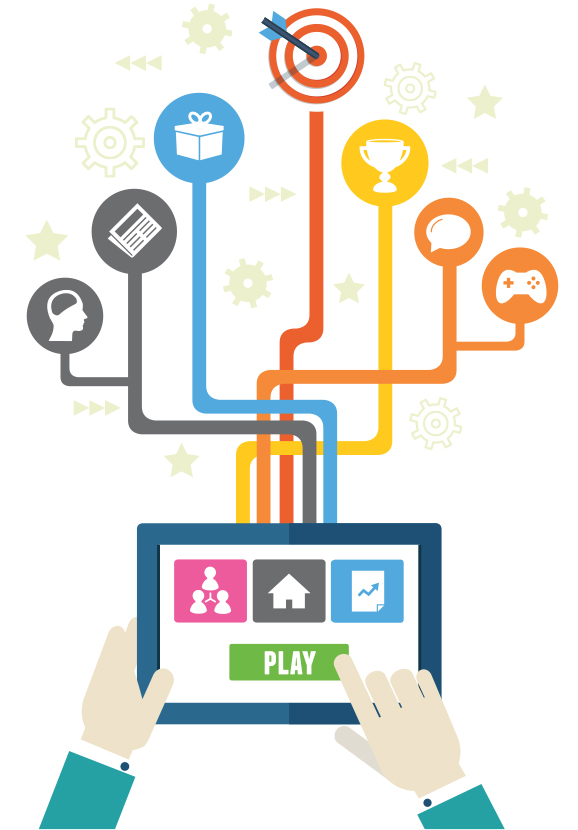This sponsored post is produced by Axonify.
Hear the words, “game,” “gaming,” or “gamer” and you might think of teenagers wasting away hours playing Call of Duty. Enter the derivative “gamification,” and by it’s pure association, it’s obvious why some organizations automatically dismiss this idea as frivolous. But, by understanding the true meaning of gamification and seeing how organizations apply it to drive competitive advantage, doubters might just be convinced to see the serious side of this innovative learning methodology.
So, what is Gamification?
Gamification isn’t about exchanging corporate laptops for game systems. It’s about integrating age-old game elements, such as earning points, overcoming challenges or receiving badges to boost employee learning and performance. After all, is it really any secret that employees find corporate training sessions as about as exciting as picking lint off a sweater?
Organizations that are brave enough to admit that lengthy presentations and courses aren’t helping employees learn or retain information any better, are embracing gamification. And, for the first time, they’re seeing employees get jazzed up about safety, customer service, sales training and other traditionally yawn-inducing topics. On top of this, they’re seeing tangible results like decreases in on-the-job accidents, reduced incidents of theft and increased sales performance.
Who says learning has to be boring?
Turning “dry content” into material that is exciting, stimulating and valuable is no easy task. But eLearning technology that integrates gamification makes it possible for organizations to help employees learn while having fun in the process. The success is based, in part, on incorporating critical gamification elements:
Game Play: Various kinds of games (e.g. arcade style, brain teasers, sports, multiplayer) ensure there’s something that appeals to everyone. Keeping sessions short and sweet (3-5 minutes) allow employees to engage in daily “play,” while questions pop up to increase learning.
Points and Rewards: Incorporating real and virtual rewards acknowledge employees’ success and foster motivation through recognition. Earning points, badges and prizes offer incentives for employees to compete (with themselves and each other) to continually achieve high scores and reach subject mastery.
Leaderboards. Leaderboards allow co-workers to engage in friendly competition at an individual or team level. Employees can track their own success, see how they stack up against their colleagues, and even check who the top performers are.
Social Elements.
News Feeds allow learners to view noteworthy events, such as when a team member graduates to a higher difficulty level in a question, or achieves a gold, silver or bronze ranking game score. This type of information gets employees talking and encourages participation.
Still skeptical? Proof is in the results.
The unique appeal of gamification is that it works across industries, roles, ages and genders. When gamification technology is applied properly in the workplace, it can engage and benefit everyone in the organization — from the mail clerk to the CEO. And the results can be so prolific that they can drive significant change:
Reduced Safety Incidents: Walmart began using gamification technology in 2012. Today, more than 75,000 U.S. associates spend a couple of minutes each day receiving safety culture content, often in the form of questions. Metrics, such as Lost Times have been reduced by more than 50% and Incident Rates and DART rates [Days Away from work, job Restrictions, and/or job Transfers] are well below industry average.
Reduced Theft: Pep Boys, a $2 Billon full-service automotive aftermarket retail chain, headquartered in Philadelphia, PA, implemented a new loss prevention awareness program in 2009 that included gamification. Since this time, Pep Boys has experienced a 55% reduction in inventory shrink rates. Shoplifting, organized crime, administrative errors and employee theft have all decreased substantially.
Increased Knowledge Retention: Full-service Canadian accounting and business advisory firm, Crowe MacKay, began using gamification technology approximately three years ago to make learning dull content more fun for their accountants. The results to date have been improved employee knowledge retention of up to 90% and 33% increased proficiency in accounting technology standards and specifications.
Clearly, gamification is serious business. And while it isn’t about gaming, it is making the difference between organizations that simply play the game and those that play to win.
Dig deeper: Download Axonify’s Gamification workbook, Gamification and Your Enterprise Learning Strategy.
Sponsored posts are content that has been produced by a company that is either paying for the post or has a business relationship with VentureBeat, and they’re always clearly marked. The content of news stories produced by our editorial team is never influenced by advertisers or sponsors in any way. For more information, contact sales@venturebeat.com.

